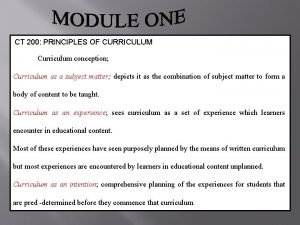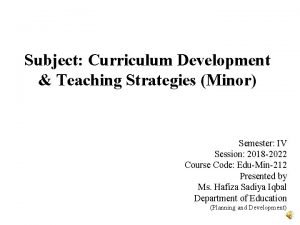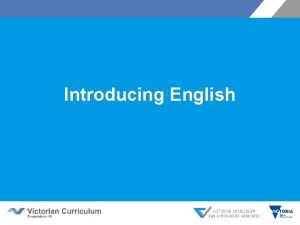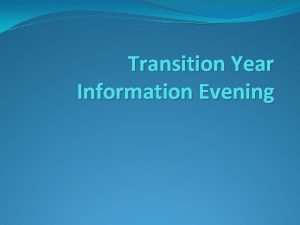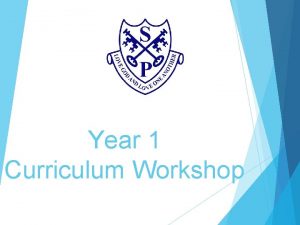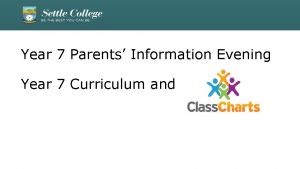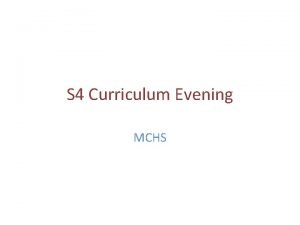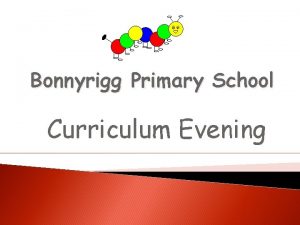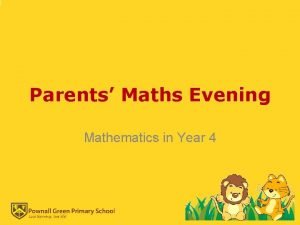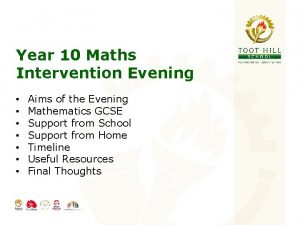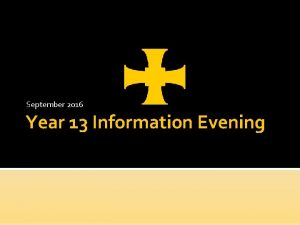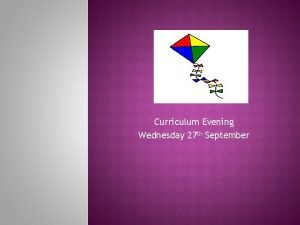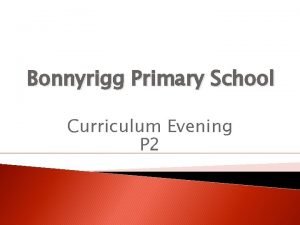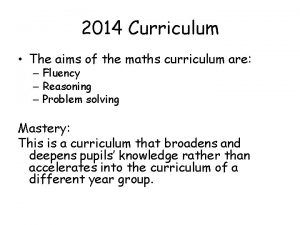Year 7 Curriculum Evening Aims To explain the




















- Slides: 20

Year 7 Curriculum Evening

Aims � To explain the structure of the Curriculum At Woodford and the philosophy that lies behind it. � To explain how we assess your daughter in Year 7. � To explain what that means for assessment, reporting and progress in Year 8 and thereafter.

Curriculum Overview 1 � Key Stage 3 (Years 7 -9) ~Girls follow the National Curriculum. ~There is no external assessment, apart from in Computing. ~Girls begin studying for GCSE Mathematics and Science in Year 9. ~Girls are assessed internally by a variety of means, including end of year examinations. The aim is to give girls a broad and balanced education, with the focus on rich learning. Assessment supports learning – not the other way around!

Curriculum Overview 2 � Key Stage 4 (Years 10 -11) ~Girls study for 10 GCSEs. ~English, Mathematics and Triple Science are compulsory, as is a Humanities and Modern Language. ~Girls are assessed externally, although some work may be marked internally before verification by the exam boards. ~The vast majority of marks are awarded through external examinations sat at the end of Year 11. ~We do not enter girls early for any subjects.

Curriculum Overview 3 � Key Stage 5 (The Sixth Form - Years 12 -13) ~Girls study either 4 A Levels or 3 A Levels plus the Extended Project or AS Mathematics ~Girls are assessed externally, although some work may be marked internally before verification by the exam boards. ~The vast majority of marks are awarded through external examinations sat at the end of Year 13. ~We do not enter girls early for any subjects except A Level Mathematics for those study A Level Further Mathematics. ~We expect virtually all girls to apply to university in Year 13.

The Year 7 Curriculum Art French Music History Computing English Science Personal, Social, Health & Careers Ed Geography German or Latin Mathematics Physical Education Religious Studies Technology (Design, Electronics, Food)

Benefits Of The National Curriculum Assessment System � We can determine what is important for students to know and understand within the framework of the National Curriculum. � We can focus on embedding real mastery and understanding. � We will no longer have to use sometimes inconsistent methods to determine NC Levels. � We can focus discussions with girls and their parents on the knowledge, skills and understanding they need to develop to progress.

Our Approach So Far � To develop a system which is appropriate for each subject. � To ensure consistency both within and across subject disciplines. � Using consistent benchmark data which everyone understands. � A system which monitors both progress and raw attainment. � A system which allows parents to understand easily the progress their child is making.

Year 7: Step 1 �Girls sat CATs to set a common benchmark. �CATs assess Verbal, Quantitative, Non-Verbal and Spatial skills. �They are a good (but not infallible) measure of academic ability and potential.

Year 7: Step 2 � During the autumn term each subject teacher evaluates the accuracy of the CATs score for each girl. � In December their feedback is collated and is used to adjust the CATs baseline prediction. � Separate predictors are set for Art, Music and PE.

Year 7: Step 3 � After Christmas, teachers continue to assess their students. � You will be informed of our initial baseline judgment. � Reports home comment on how far girls were making the expected progress based upon their revised baseline score. � Because we are reporting progress girls with the same grade might receive different comments if their baseline scores were very different. � In July the baseline scores are reviewed again.

The Baseline Score What does it mean?

THE CATs TESTS � QUANTITATIVE – The ability to reason via the use of numbers. � VERBAL – The ability to reason via the use of language. � NON-VERBAL – The ability to reason via the use of images. � SPATIAL - The ability to reason by visualising shapes and patterns and thinking in three dimensions. � Girls receive an age-adjusted score for each, plus a mean score. � A combination of these produces a GCSE prediction.

The GCSE Prediction

The Spread Of Grades CATS Score Expected Grade Spread 105 Mainly grades 5 & 6; some grade 7. 110 A mixture of grades 7, 6 and 5 115 Roughly an equal mixture of grades 6 & 7 120 Mainly grades 6 & 7; some grade 8 125 Mainly grades 7 & 8; some grade 6 130 Mainly grades 7 -9 135 Mainly grades 8 & 9

Accuracy of Expected Grades

Please Bear In Mind… � These are statistical predictions, not prophesies. � Motivation and effort have a huge impact on success. � Other factors may affect whether the statistical prediction proves accurate – health, luck, unexpected events, personal circumstances.

Year 8 And Beyond � Your daughter will be given a school-adjusted baseline. Not the same as a CATS score. � She may have a different baseline for Art, Music or PE. � Progress will be measured against this baseline during Year 8. � Teacher assessment, feedback and reporting will take this into account. � Its accuracy will be reassessed at the end of Year 8 and further adjustments made.

Starting GCSEs � We will set target grades at the start of Year 10 using this data and FFT. � It will also play a part (along with internal assessment data) in setting in Science and Mathematics. � It will not be used to determine GCSE entry decisions such as tiering. This is based on performance during Years 10 and 11. � It is expected that all girls will be entered for 10 GCSEs.

Your Daughter’s Baseline � You will receive notification of this in January. � It will look like this: NAME: Imaginary Person Based on our assessment of your daughter’s academic achievement during the autumn term of Year 7 we would expect her to achieve mainly grades 7 -9 at GCSE.
 Cloud ninestiles
Cloud ninestiles Objectives of the curriculum
Objectives of the curriculum Objective of curriculum
Objective of curriculum When was established mudaliar commission
When was established mudaliar commission Leavers poem year 6
Leavers poem year 6 Year 8 curriculum victoria
Year 8 curriculum victoria Ausvels english
Ausvels english Hình ảnh bộ gõ cơ thể búng tay
Hình ảnh bộ gõ cơ thể búng tay Bổ thể
Bổ thể Tỉ lệ cơ thể trẻ em
Tỉ lệ cơ thể trẻ em Voi kéo gỗ như thế nào
Voi kéo gỗ như thế nào Tư thế worm breton
Tư thế worm breton Chúa yêu trần thế
Chúa yêu trần thế Môn thể thao bắt đầu bằng từ chạy
Môn thể thao bắt đầu bằng từ chạy Thế nào là hệ số cao nhất
Thế nào là hệ số cao nhất Các châu lục và đại dương trên thế giới
Các châu lục và đại dương trên thế giới Công thức tính thế năng
Công thức tính thế năng Trời xanh đây là của chúng ta thể thơ
Trời xanh đây là của chúng ta thể thơ Mật thư anh em như thể tay chân
Mật thư anh em như thể tay chân 101012 bằng
101012 bằng

